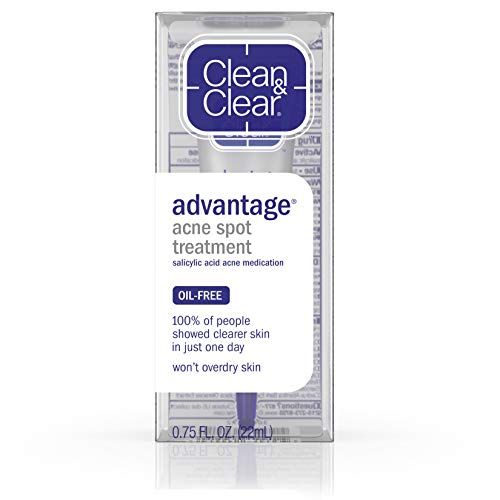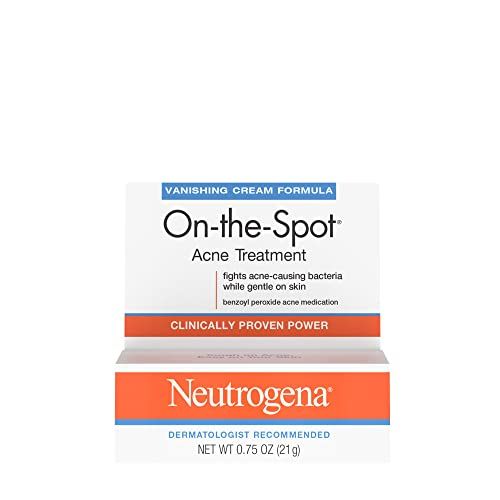Searching for smooth, bump-free skin? Figuring out how to get rid of whiteheads is a great place to start. But, if you are prone to those pesky little bumps, you’ve likely gone through a laundry list of solutions—from adult acne treatment to the best acne spot treatments to simply figuring out what order to apply skincare products. If you find yourself still searching for how to maintain healthy skin, sans whiteheads, we tapped the experts to get you cleaner skin, pronto.
There are plenty of different types of skin spots, bumps, and blemishes we refer to when talking about acne—whiteheads serving as one of the most annoying kinds. “Usually there’s some type of hormonal trigger,” explains Mona Gohara M.D., a board-certified dermatologist and vice president of the Women’s Dermatologic Society. “That creates more oil production in the sebaceous gland, and then when there’s more oil production in the sebaceous gland, oftentimes keratin and dead skin cells accumulate and create a whitehead.” So, a whitehead is essentially a clogged pore (like blackheads, but a little different).
The good news is that there are many treatments available for getting rid of whiteheads. However, your best bet is to let the tried-and-true topicals (available both from your dermatologist and over the counter) do their intended job. In other words, if you’re simultaneously looking up how to pop a pimple—don’t. Instead, keep reading to learn all about whiteheads from the experts—what they are, what they look like, and what you can do to treat them.
What are whiteheads
“Another name for a whitehead is a closed comedone,” explains Dr. Gohara. A comedone is essentially a clogged pore, and a closed comedone “means that there’s a layer of skin over it [the clogged pore] that kind of creates a little bump,” Dr. Gohara continues.
So, why might you get whiteheads? Dr. Gohara explains that we have sebaceous glands (oil glands) in our skin, and sometimes a mix of oils, skin cells, and skin proteins called keratin can accumulate and clog the follicle, or pore. When your pores get clogged, a whitehead can form.
What do whiteheads look like?
Oftentimes, a whitehead can be confused for another type of acne or bump—but “whiteheads are small bumps on the skin that are smooth and either white or skin-colored,” explains Marie Leger, M.D., Ph.D., F.A.A.D., a board-certified dermatologist at Entière Dermatology in New York City. “They are not usually inflammatory, meaning there is no red around them.”
It’s also important to note that whiteheads are not the same as those pus-filled acne bumps you might sometimes experience. “Pus connotes that it’s an infection, right? It’s not an infection,” explains Dr. Gohara.
How to get rid of whiteheads
Good news: there’s an abundance of ways to get rid of and prevent whiteheads, from home remedies to over-the-counter blemish-fighting products to prescription-strength options. Below, find a variety of different treatments to help determine what might work best for you.
Home remedies and natural remedies
Witch hazel
“Witch hazel, which is a plant extract, contains compounds called tannins that have both antioxidant and astringent properties to fight acne,” Joshua Zeichner, M.D., director of cosmetic and clinical research in dermatology at Mount Sinai Hospital in New York City previously told Prevention.
Grapeseed oil
It may sound counterintuitive to apply oil to your skin, but grapeseed oil contains high levels of linoleic acid, an omega-6 fatty acid that can help control blemishes by decreasing clogged pores. When skin is deficient in linoleic acid, the sebum (oil) becomes “thick and sticky, leading to clogged pores,” Susan Bard, M.D., board-certified dermatologist previously explained.
Tea tree oil
Tea tree oil can be helpful in reducing inflammation and bacteria, Marisa Garshick, M.D., F.A.A.D., a board-certified dermatologist in New York previously told Prevention. However, like other natural and home remedies, it may be irritating to the skin so be careful and consult your dermatologist before trying anything at home.
Over-the-counter products
Retinol
“Retinols are the gold standard in treating whiteheads,” Dr. Gohara continues. “Retinols help to regulate the shedding of the hair follicle and the sebaceous follicle, and help to minimize the oil production that goes into the accumulation of these dead skin cells and proteins.”
Benzoyl peroxide
Benzoyl peroxide is a powerful acne-fighting ingredient that can be found over the counter in strengths up to 10%. Benzoyl peroxide products help target bacteria in the skin and can act as an anti-inflammatory, explains Dr. Gohara.
Alpha and beta hydroxy acids
Alpha hydroxy acid (AHA) like glycolic acid and beta hydroxy acid (BHA) like salicylic acid is another route you can take to get rid of whiteheads, “both of which are great at exfoliating,” helping to get rid of dead skin and unclog the pores, says Dr. Gohara.
Prescription options
Retinoids
“Comedonal acne—consisting of both blackheads and whiteheads is best treated by a retinoid—like adapalene (0.1% is available over the counter), tretinoin, tazarotene, or trifarotene,” explains Dr. Leger. “These medications can be notoriously drying and irritating, so they will often be prescribed for just a few days a week and you can work up to nightly if tolerated.” Like their more gentle counterpart, retinol, retinoids help to regulate skin cell and oil production in the skin, keeping pores clear.
Antibiotics
While a less popular option compared to prescription retinoids, topical antibiotics may also be prescribed by your dermatologist to help manage whiteheads, especially if you are dealing with other types of blemishes and acne, Dr. Gohara notes.
How to get rid of whiteheads overnight
While you might be looking for a bit of instant gratification when it comes to smooth skin, getting rid of whiteheads overnight may not be entirely possible. However, the methods here for getting rid of whiteheads are dermatologists’ go-to treatment options and should have your skin clear in no time.
How to prevent whiteheads
“The best way to prevent [whiteheads] is weekly exfoliation,” either with alpha hydroxy acid, beta hydroxy acid, or retinols, explains Dr. Gohara. “And then just be aware of potential triggers, especially in the case of frictional stuff.” For example, if you tend to break out in whiteheads after working out in the area of your sports bra, wipe that area down with a glycolic acid wipe right after working out, suggests Dr. Gohara.
Additionally, Dr. Leger notes that haircare products tend to be a common culprit for whiteheads, which usually “looks like a smattering of whiteheads on the temples or upper forehead, often in my patients with bangs or who use leave-in conditioners, gels, or other styling products,” she says. If this sounds like you, try using less heavy or less oily products or avoid using haircare around the face and hairline.
When to see a doctor
In the case of whiteheads, there are a variety of great over-the-counter treatments available to help—but when you feel like you’ve exhausted all those options with no success, then you should see a dermatologist. You may need prescription treatments or you might be experiencing something other than whiteheads entirely, like milia, fungal acne, or folliculitis, according to Dr. Gohara.
“Usually, if something’s not going away, you’re either not using the right treatment, or you don’t have the right diagnosis,” says Dr. Gohara. “So in those instances, I would see a dermatologist.” Additionally, Dr. Leger notes that if you experience other skin conditions like rosacea, eczema, dry skin, or allergies in addition to whiteheads, a dermatologist can be helpful in creating a plan of action that considers those as well.
The difference between whiteheads and blackheads
Blackheads are very similar to whiteheads in that they are both essentially clogged pores. However, while a whitehead is classified as a “closed comedone,” with a layer of skin covering the clogged pore, “blackheads do not have that layer of skin over it,” says Dr. Gohara. “And so when the skin cells and the skin protein (keratin) hit oxygen in the air, sometimes they can oxidize and turn black—and so they’re called open comedones.
Freelance Editorial Assistant
Shannen Zitz is a Freelance Editorial Assistant at Prevention who recently graduated from the State University of New York at Cortland with an English degree. She loves all things fashion, beauty, and wellness. If she’s not reading or writing, you can probably find her frequenting the skincare and makeup forums on Reddit.




